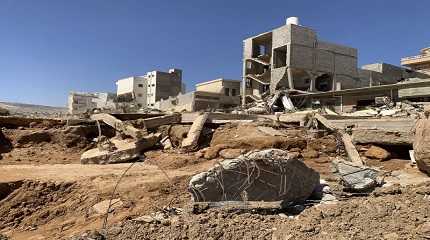
DERNA, Libya (AP) — Libyan authorities limited access to the flooded city of Derna on Friday to make it easier for searchers to dig through the mud and hollowed-out buildings for the more than 10,000 people still missing and presumed dead following a disaster that has already claimed more than 11,000 lives.
The staggering death toll could grow further due to the spread of waterborne diseases and shifting of explosive ordnance that was swept up when two dams collapsed early Monday and sent a wall of water gushing through the city, officials warned.
The disaster has brought some rare unity to oil-rich Libya, which after years of war and civil strife is divided between rival governments in the country’s east and west that are backed by various militia forces and international patrons. But the opposing governments have struggled to respond to the crisis, and recovery efforts have been hampered by confusion, difficulty getting aid to the hardest-hit areas, and the destruction of Derna’s infrastructure, including several bridges.
Aid groups called on the government to facilitate their access to the city so they can distribute badly needed food, clean water and medical supplies to survivors. Four days into the crisis, the lack of central oversight in Derna was apparent, with people receiving supplies and resources in some parts of the city but being left to fend for themselves in others.
Teams have buried bodies in mass graves outside the city and in nearby towns, Eastern Libya’s health minister, Othman Abduljaleel, said.
But officials worried that thousands more have yet to be found.
Bodies “are littering the streets, washing back up on shore and buried under collapsed buildings and debris,” said Bilal Sablouh, regional forensics manager for Africa at the International Committee of the Red Cross.
“In just two hours, one of my colleagues counted over 200 bodies on the beach near Derna,” he said.
Divers are also searching the waters off the Mediterranean coastal city.
Adel Ayad, who survived the flood, recalled watching as the waters rose to the fourth floor of his building.
“The waves swept people away from the tops of buildings, and we could see people carried by floodwater,” he said. Among them were neighbors.
Salam al-Fergany, director general of the Ambulance and Emergency Service in eastern Libya, said late Thursday that residents would be evacuated from Derna and that only search-and-rescue teams would be allowed to enter. But there were no signs of such an evacuation on Friday.
Health officials warned that standing water opened the door to disease — but said there was no need to rush burials or put the dead in mass graves, as bodies usually do not pose a risk in such cases.
“You’ve got a lot of standing water. It doesn’t mean the dead bodies pose a risk, but it does mean that the water itself is contaminated by everything,” Dr. Margaret Harris, spokeswoman for the World Health Organization, told reporters in Geneva. “So you really have to focus on ensuring that people have have access to safe water.”
Imene Trabelsi, a spokesperson for the International Committee of the Red Cross, warned that another danger lurked in the mud: landmines and other explosives left behind by the country’s protracted conflict.
There are leftover explosives in Libya dating back to World War II, but most are from the civil conflict that began in 2011. Between 2011 and 2021, some 3,457 people were killed or wounded by landmines or other leftover explosive ordnance in Libya, according to the international Landmine and Cluster Munition Monitor.
Even before the flooding, Trabelsi said the ability to detect and remove mines from areas was limited. After the floods, she said, explosive devices may have been swept to “new, undetected areas” where they could pose an immediate threat to search teams and a longer-term threat to civilians.
According to the Libyan Red Crescent, there were 11,300 flooding deaths in Derna as of Thursday. Another 10,100 people were reported missing, though there was little hope many of them would be found alive, the aid group said. The storm also killed about 170 people elsewhere in the country.
Libyan media reported that dozens of Sudanese migrants were killed in the disaster. The country has become a major transit point for Middle Eastern and African migrants fleeing conflict and poverty to seek a better life in Europe.
Flooding often happens in Libya during the rainy season, but rarely with this much destruction. Scientists said the storm bore some of the hallmarks of climate change, and extremely warm sea water could have given the storm more energy and allowed it to move more slowly.
Officials have said that Libya’s political chaos also contributed to the loss of life. Khalifa Othman, a Derna resident, said he blamed authorities for the extent of the disaster.
“My son, a doctor who graduated this year, my nephew and all his family, my grandchild, my daughter and her husband are all missing, and we are still searching for them,” Othman said. “All the people are upset and angry — there was no preparedness.”




